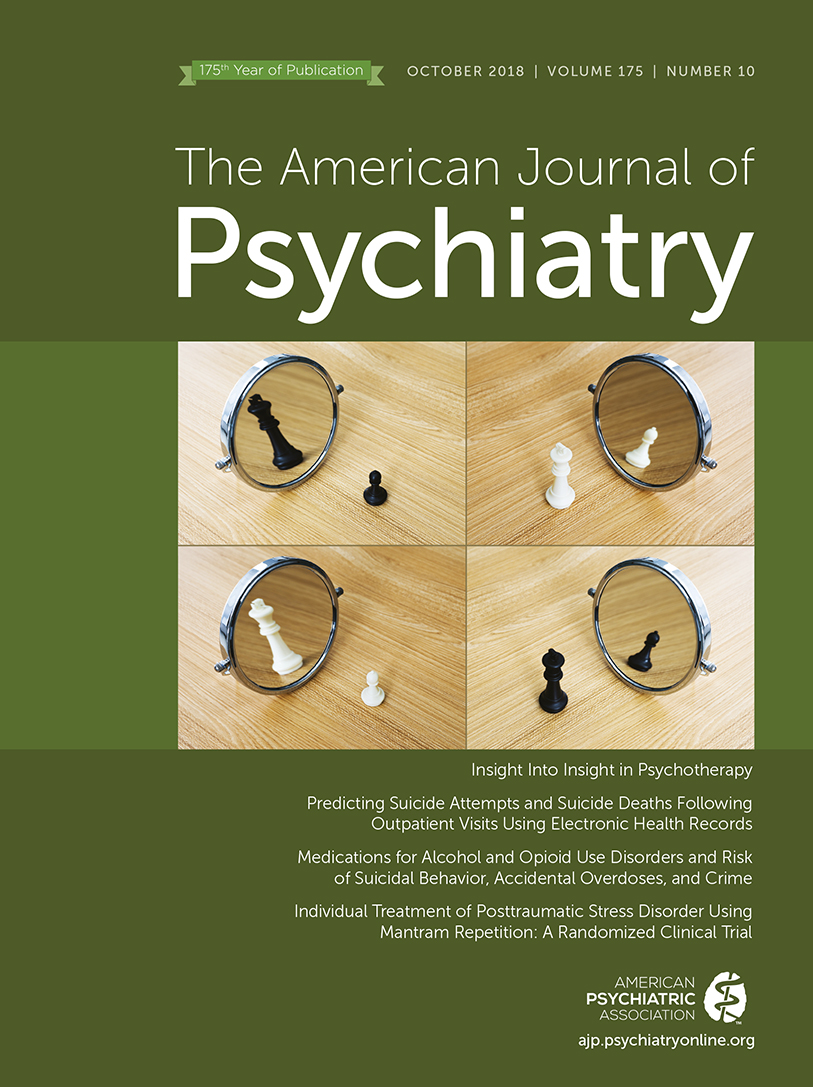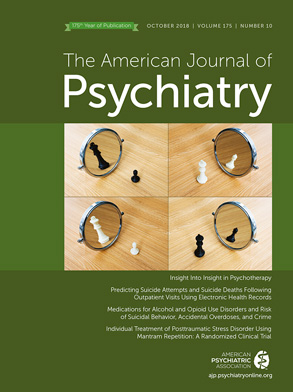Posttraumatic stress disorder (PTSD) officially became part of DSM with DSM-III in 1980, in part as a result of recognition of the profound impact of combat stress on Vietnam War veterans. Given its relatively recent recognition as a mental health disorder, clinical outcome research on PTSD is arguably still in its infancy relative to other areas of psychiatric or medical research. Several guidelines have been developed to inform clinicians on which psychosocial treatments should be considered in clinical practice with PTSD. The American Psychological Association recently updated its guidelines (
1) and “strongly recommends” (a designation requiring the strongest level of evidence) prolonged exposure and cognitive processing therapy as well as cognitive-behavioral therapy and cognitive therapy more generally. Eye movement desensitization and reprocessing therapy (EMDR), brief eclectic psychotherapy, and narrative exposure therapy are also “suggested.” Similarly, the guidelines from the Department of Veterans Affairs and the Department of Defense (
2) recommend using trauma-focused psychotherapy (including cognitive processing therapy, prolonged exposure, brief eclectic psychotherapy, and EMDR) as first-line treatment options for veterans with PTSD. The central role of trauma-focused therapies in these guidelines is due not only to evidence for their efficacy but also theories concerning the psychological mechanisms underlying the development, maintenance, and treatment of PTSD. Emotional processing theories suggest that emotional engagement with trauma memories or modification of trauma-related beliefs is necessary for recovery (see reference
3 for a recent review). Fear extinction or corrective learning related to the trauma and associated cues or contexts is also often posited as a central mechanism for PTSD treatment (
3). Many of us within the PTSD research field have subsequently become somewhat dogmatic about the presumed essentiality of trauma processing for the effective treatment of PTSD.
Unfortunately, trauma-focused therapies are not a panacea, and they often have high dropout and nonresponse rates (
4). There are actually fewer rigorous PTSD clinical trials with combat veterans than with civilian populations, and from those that have been conducted, there is some evidence that efficacy may be lower. In studies that have been conducted with veterans using trauma-focused therapies, only 50%−70% experience clinically significant improvement and only 30%−40% no longer meet diagnostic criteria for PTSD (see reference
5 for a review). While superiority to waiting list control conditions cannot be disputed, studies comparing cognitive processing therapy or prolonged exposure to an active comparator (present-centered therapy) for veterans or active military personnel report modest and mixed results (
5). It is therefore quite obvious that optimal outcomes are not being obtained using current gold-standard, trauma-focused interventions.
Thus, it is in the context of alarmingly low levels of support for trauma-focused therapies in combat-related PTSD that we read the article by Bormann and colleagues in this issue of the
Journal (
6). In a study comparing present-centered therapy and individually delivered “mantram” repetition therapy, the authors report that mantram repetition therapy is associated with greater improvement in symptoms on the Clinician-Administered PTSD Scale (CAPS) and the insomnia severity index at posttreatment and 2-month follow-up assessments as compared with present-centered therapy (effect sizes [Cohen’s d], 0.49 at posttreatment assessment and 0.46 at 2-month follow-up). Approximately 75% of participants in the mantram group had greater than a 10-point decrease on the CAPS; at the posttreatment assessment, 48% no longer met criteria for PTSD, and at the 2-month follow-up assessment, 59% no longer met criteria. These gains are more impressive when considering the relatively brief duration of treatment (8 weeks).
Interest in the use of mindfulness- or meditation-based interventions for PTSD has been clear from the number of recent pilot studies or waiting list control trials on the topic. However, the Bormann et al. study is notable in that it was adequately powered (total N=173, making it one of the larger clinical outcome trials in combat-related PTSD) and the first randomized controlled study to compare mantram repetition therapy to the active comparator intervention often used in clinical trials of trauma-focused interventions. Interestingly, another recent randomized controlled PTSD outcome study (in civilian populations) reported that interpersonal psychotherapy produced benefits similar to those of prolonged exposure, both of which were superior to relaxation therapy (
7). Thus, evidence is mounting that non-trauma-focused therapies may have at least equal efficacy for the treatment of PTSD as compared with trauma-focused interventions.
These recent findings may tempt clinicians to abandon trauma-focused therapies altogether, particularly given some perceptions concerning the difficulty of implementing these interventions and the (temporary) distress elicited in patients (
8). However, there are several notes of caution in this regard. First, it would be optimal to have replication of these findings by independent groups and with a variety of veteran and civilian populations (e.g., female veterans, people living in different regions of the country, and sexual assault victims). Second, there is always the possibility that the newest intervention on the block will have greater placebo effects simply because of novelty effects. Third, only head-to-head trials with trauma-focused therapies can elucidate noninferiority (or superiority) of these newer interventions. Perhaps most importantly, we need to be careful not to take news of positive results from novel interventions as evidence that the standard interventions should be neglected. Instead, we should rejoice in the potential expansion of our intervention toolbox for PTSD. It can be viewed as akin to the development of new pharmacologic agents with different mechanisms of action. When one efficacious intervention does not work for an individual, we have other potentially effective interventions to offer.
Theories underlying mantram repetition therapy would suggest divergence from those of trauma-focused therapies. As opposed to focusing on trauma-related memories or cognitions, mantram repetition therapy teaches how to use repetition of a word or phrase with personal spiritual meaning in order to heighten present awareness (
9). Proposed psychological mechanisms for mantram repetition therapy and other mindfulness- or meditation-based interventions include reducing reactivity to stressors, enhancing relaxation, enhancing attentional control, and decreasing ruminative tendencies (
9). Additional research would be useful in 1) further delineating these psychological mechanisms as well as potentially unique neurobiological mechanisms of action and 2) identifying differential predictors of response to each treatment. Such research would help us identify which interventions (e.g., trauma-focused, mantram repetition or other mindfulness-based interventions, interpersonal psychotherapy) may be optimal for which individuals.
Bormann and colleagues’ findings may challenge deeply held beliefs about the centrality of trauma-focused processing in recovery from PTSD. Others may take it as validation for their prior cynicism regarding trauma-focused therapy or as a beacon of light amid the mixed and limited clinical outcome literature with combat veterans. Neither complete rejection nor infatuation with these results will help move the field forward in a productive way. Instead, these findings should be a call for more research to be conducted to determine the robustness and generalizability of various PTSD treatments (particularly for veteran populations) as well as unique mechanisms and predictors of response. Such research will provide the potential for a more personalized-medicine approach to the psychosocial treatment of PTSD and ultimately lead to greater improvements in the lives of combat veterans and other trauma survivors.
Acknowledgments
Dr. Aupperle receives funding from NIH (K23MH108707).

